上颌推磨牙远移技术演示文稿
- 格式:ppt
- 大小:933.00 KB
- 文档页数:21

推磨牙远移技术进展杨志伟【摘要】@@ 临床上对于安氏Ⅱ类错伴牙源性前牙拥挤的病例,需开拓间隙排齐拥挤前牙同时矫正Ⅱ类磨牙关系.正畸临床中开拓间隙的主要手段是减小牙量或(和)扩大牙弓,使牙量与骨量趋于协调,同时兼顾牙、颌、面三者之间的协调性、稳定性和颜面美观[1].【期刊名称】《贵州医药》【年(卷),期】2011(035)007【总页数】4页(P661-664)【作者】杨志伟【作者单位】贵阳市口腔医院,55000l【正文语种】中文【中图分类】R783.5临床上对于安氏Ⅱ类错牙合伴牙源性前牙拥挤的病例,需开拓间隙排齐拥挤前牙同时矫正Ⅱ类磨牙关系。
正畸临床中开拓间隙的主要手段是减小牙量或(和)扩大牙弓,使牙量与骨量趋于协调,同时兼顾牙、颌、面三者之间的协调性、稳定性和颜面美观[1]。
减小牙量的方法包括拔牙和邻面去釉,拔牙虽是获得间隙的最好方式,但并非所有病例都适合拔牙;邻面去釉虽可避免拔牙而获得间隙,但有严格的适应症,获得间隙的量也非常有限。
牙弓扩展包括长度与宽度扩展,是增加骨量的主要措施。
其中,牙弓长度扩展的方法主要有唇展前牙和推磨牙远中移动;牙弓宽度扩展方法主要有腭中缝扩展、牙弓正畸扩展及牙齿-齿槽骨功能性扩展。
唇展前牙也有其明确的适应症,通过牙弓横向扩展以增加牙弓宽度和长度是获得间隙的方法之一,但矫治效果受患者年龄影响较大,且咬合关系不够稳定,易导致不可避免的复发;而推磨牙远中移动开拓间隙是正畸临床较常用的一种方法。
近年来,国内外正畸医生对于拔牙矫治多持慎重态度,在结合考虑患者颅、颌、面关系后,多采用少拔或不拔牙原则,作为非拔牙矫治重要内容的推磨牙远移开拓间隙则成为临床研究热点之一。
现将推磨牙远中移动的可行性以及各种推磨牙远移装置的作用原理及临床特点作一综述。
1 推磨牙向远中移动的解剖生理依据推磨牙向远中移动近来开展的较为普遍,除科学的进步、矫治技术水平提高之外,还有其内在的物质基础。
首先上颌结节是上颌生长发育的中心之一,上颌结节作为磨牙远中移动的物质基础从解剖结构可知,上颌骨为疏松多孔结构,有丰富的血液循环,骨改建活跃。
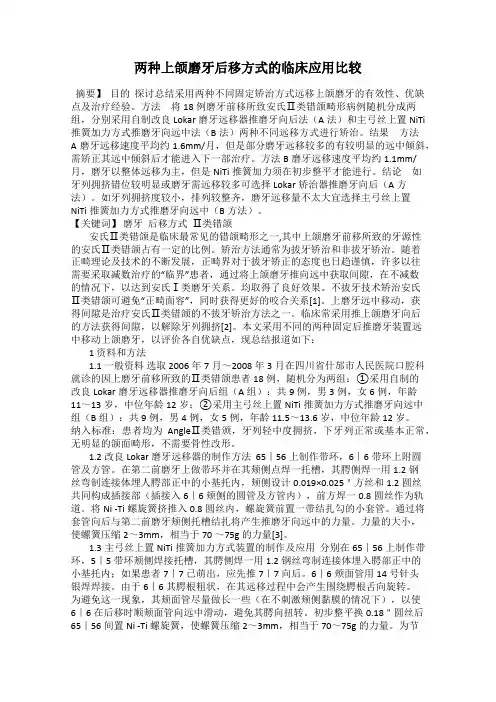
两种上颌磨牙后移方式的临床应用比较摘要】目的探讨总结采用两种不同固定矫治方式远移上颌磨牙的有效性、优缺点及治疗经验。
方法将18例磨牙前移所致安氏Ⅱ类错颌畸形病例随机分成两组,分别采用自制改良Lokar磨牙远移器推磨牙向后法(A法)和主弓丝上置NiTi 推簧加力方式推磨牙向远中法(B法)两种不同远移方式进行矫治。
结果方法A磨牙远移速度平均约1.6mm/月,但是部分磨牙远移较多的有较明显的远中倾斜,需矫正其远中倾斜后才能进入下一部治疗。
方法B磨牙远移速度平均约1.1mm/月,磨牙以整体远移为主,但是NiTi推簧加力须在初步整平才能进行。
结论如牙列拥挤错位较明显或磨牙需远移较多可选择Lokar矫治器推磨牙向后(A方法)。
如牙列拥挤度较小,排列较整齐,磨牙远移量不太大宜选择主弓丝上置NiTi推簧加力方式推磨牙向远中(B方法)。
【关键词】磨牙后移方式Ⅱ类错颌安氏Ⅱ类错颌是临床最常见的错颌畸形之一,其中上颌磨牙前移所致的牙源性的安氏Ⅱ类错颌占有一定的比例。
矫治方法通常为拔牙矫治和非拔牙矫治。
随着正畸理论及技术的不断发展,正畸界对于拔牙矫正的态度也日趋谨慎,许多以往需要采取减数治疗的“临界”患者,通过将上颌磨牙推向远中获取间隙,在不减数的情况下,以达到安氏Ⅰ类磨牙关系。
均取得了良好效果。
不拔牙技术矫治安氏Ⅱ类错颌可避免“正畸面容”,同时获得更好的咬合关系[1]。
上磨牙远中移动,获得间隙是治疗安氏Ⅱ类错颌的不拔牙矫治方法之一。
临床常采用推上颌磨牙向后的方法获得间隙,以解除牙列拥挤[2]。
本文采用不同的两种固定后推磨牙装置远中移动上颌磨牙,以评价各自优缺点,现总结报道如下:1 资料和方法1.1 一般资料选取2006年7月~2008年3月在四川省什邡市人民医院口腔科就诊的因上磨牙前移所致的Ⅱ类错颌患者18例,随机分为两组:①采用自制的改良Lokar磨牙远移器推磨牙向后组(A组):共9例,男3例,女6例,年龄11~13岁,中位年龄12岁;②采用主弓丝上置NiTi推簧加力方式推磨牙向远中组(B组):共9例,男4例,女5例,年龄11.5~13.6岁,中位年龄12岁。
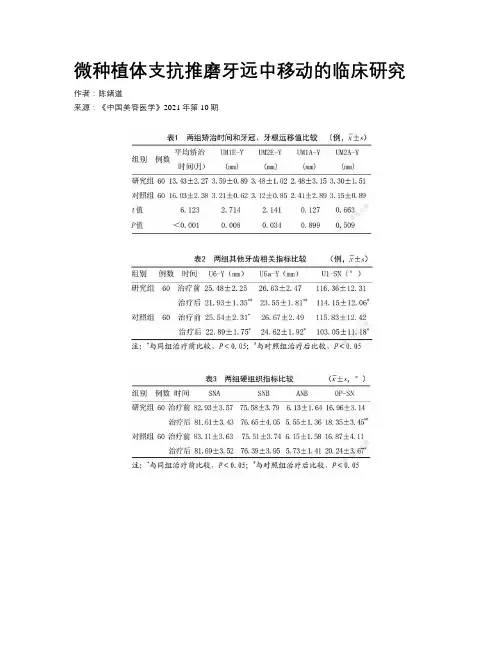
微种植体支抗推磨牙远中移动的临床研究作者:***来源:《中国美容医学》2021年第10期[摘要]目的:探究微种植体支抗推磨牙远中移动矫治安氏Ⅱ类错牙合畸形的临床疗效。
方法:回顾性分析2016年1月-2018年12月于笔者医院接受传统口外弓支抗治疗(对照组,n=60)及接受微种植体支抗治疗(研究组,n=60)的安氏Ⅱ类的错牙合畸形患者的临床资料。
对比两组矫治时间,计算两组牙冠、牙根远移值[上颌第一磨牙牙冠平均远中移动值(UM1E-Y)、上颌第二磨牙牙冠平均远中移动值(UM2E-Y)、第一磨牙牙根平均远移值(UM1A-Y)、第一磨牙牙根平均远移值(UM2A-Y)],比较两组治疗前后的其他牙齿相关指标[上颌第一磨牙近中颊尖点至Y轴的距离(U6-Y)、上颌第一磨牙牙根尖点至Y轴的距离(U6a-Y)、上颌中切牙长轴与SN平面夹角(U1-SN)]、硬组织指标[上齿、下齿槽座角(SNA、SNB)、上下齿槽座角(ANB)、牙合平面与SN平面夹角(OP-SN)]、软组织相关指标[上唇突度、下唇突度、鼻唇角(NLA)、上唇突距(Ls-E)]及咀嚼功能(咬合力、咀嚼效率)的差异。
结果:研究组平均矫治时间显著短于对照组(P0.05),而对照组较治疗前显著降低(P0.05),而OP-SN较治疗前上升(P0.05),而研究组OP-SN显著低于对照组(P[关键词]安氏Ⅱ类错牙合畸形;微种植体支抗;磨牙远移;咬合功能[中图分类号]R783.5 [文献标志码]A [文章编号]1008-6455(2021)10-0157-04Clinical Study on Micro-Implant Anchorage for Molar DistalizationCHEN Xu-dao(Department of Stomatology,Dazhou Integrated TCM &Western Medicine Hospital,Dazhou 635000, Sichuan, China)Abstract:Objective To explore the clinical efficacy of micro-implant anchorage for molar distalization in correcting Angle Class Ⅱmalocclusion. Methods A retrospective analysis was performed on clinical data of patients with Angle Class Ⅱ malocclusion who received traditional headgear anchorage treatment (control group, n=60) or received micro-implant anchorage treatment (study group, n=60)in our hospital from January 2016 to December 2018. The correction time was combined between the two groups, and the crown and root distalization values [average distalization value of maxillary first molar crown (UM1E-Y), average distalization value of maxillary second molar crown (UM2E-Y), average distalization value of first molar root (UM1A-Y), average distalization value of second molar root (UM2A-Y)] were calculated in the two groups. The tooth-related indicators [the distance from maxillary first molar mesiobuccal tip to Y axis (U6-Y), the distance from maxillary first molar root apex tip to Y axis (U6a-Y),angle between the long axis of maxillary central incisor and the SN plane (U1-SN)], hard tissue indicators [sella-nasion-A point, sella-nasion-B point (SNA, SNB), A point-nasion-B point (ANB), occlusal plane-SN plane angle (OP-SN)], soft tissue-related indicators [upper lip protrusion (Ls-SnPg), lower lip protrusion (Li-SnPg), nasolabial angle (NLA), upper lip protrusion distance (Ls-E)] and masticatory function (occlusal force, masticatory efficiency) before and after treatment were compared between the two groups. Results The average correction time in study group was significantly shorter than that in control group (P0.05), andU1-SN in control group was significantly lower than that before treatment (P0.05), and OP-SN was higher than that before treatment (P0.05), and OP-SN in study group was significantly lower than that in control group (PKey words: Angle ClassⅡ malocclusion; micro-implant anchorage; molar distalization; occlusal function安氏Ⅱ类错牙合畸形可分为1、2两个分类,其中安氏Ⅱ类1分类错牙合畸形在我国青少年人群恒牙期的患病率约20%,不仅影响患者牙齿咀嚼功能、牙列整齐,也会影响其面貌美观,不利于患者身心健康[1]。
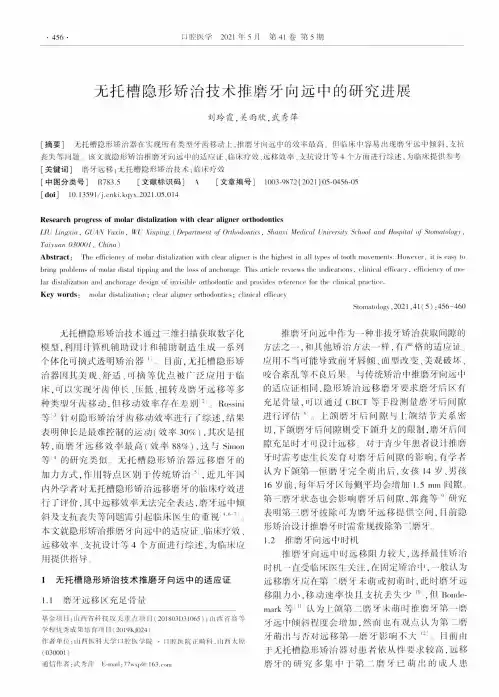
• 456 .口腔医学2021年5月第41卷第5期无托槽隐形矫治技术推磨牙向远中的研究进展刘玲霞,关雨欣,武秀萍[摘要]尤托槽隐形矫治器在实现所有类型牙齿移动上,推磨牙向远中的效率最高但临床中容易出现磨牙远中倾斜,支抗 丧失等问题该文就隐形矫治推磨牙向远中的适应证、临床疗效、远移效率、支抗设计等4个方面进行综述,为临床提供参芍[关键词]磨牙远移;无托槽隐形矫治技术;临床疗效[中图分类号]R783.5 [文献标识码]A[文章编号]1003-9872(2021)05-0456-05[doi] 10.13591 /ki.kqyx.2021.05.014Research progress of molar distalization with clear aligner orthodonticsLIU Lingxia, GUAN YiLxin, Wl) Xiuping. ( Department of Orthodontics, Shanxi Medical University School and Hospital of Stomatology, Taiyuan 030001, China)Abstract :File efficiency of molar distalization with clear aligner i s the highest in all types of tooth m o v e ments.H o w e v e r,i t i s easy to bring prol)lems of molar distal tipping and the loss of anchorage.This article reviews the indications,clinical efficacy,efficiency of m olar distalization and anchorage design of invisible orthodontic and provides reference for the c linical practice.Key words:molar distalization;clear aligner orthodontics;clinical efficacyStomatology,2021 ,41(5) :456-460无托槽隐形矫治技术通过三维扫描获取数字化 模型,利用计算机辅助设计和辅助制造生成一系列 个体化可摘式透明矫治器11。
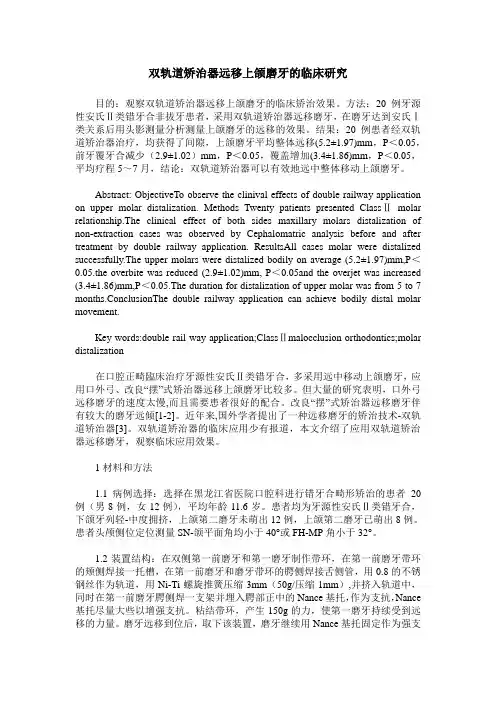
双轨道矫治器远移上颌磨牙的临床研究目的:观察双轨道矫治器远移上颌磨牙的临床矫治效果。
方法:20例牙源性安氏Ⅱ类错牙合非拔牙患者,采用双轨道矫治器远移磨牙,在磨牙达到安氏Ⅰ类关系后用头影测量分析测量上颌磨牙的远移的效果。
结果:20例患者经双轨道矫治器治疗,均获得了间隙,上颌磨牙平均整体远移(5.2±1.97)mm,P<0.05,前牙覆牙合减少(2.9±1.02)mm,P<0.05,覆盖增加(3.4±1.86)mm,P<0.05,平均疗程5~7月,结论:双轨道矫治器可以有效地远中整体移动上颌磨牙。
Abstract: ObjectiveTo observe the clinival effects of double railway application on upper molar distalization. Methods Twenty patients presented ClassⅡmolar relationship.The clinical effect of both sides maxillary molars distalization of non-extraction cases was observed by Cephalomatric analysis before and after treatment by double railway application. ResultsAll cases molar were distalized successfully.The upper molars were distalized bodily on average (5.2±1.97)mm,P<0.05.the overbite was reduced (2.9±1.02)mm, P<0.05and the overjet was increased (3.4±1.86)mm,P<0.05.The duration for distalization of upper molar was from 5 to 7 months.ConclusionThe double railway application can achieve bodily distal molar movement.Key words:double rail way application;ClassⅡmalocclusion orthodontics;molar distalization在口腔正畸臨床治疗牙源性安氏Ⅱ类错牙合,多采用远中移动上颌磨牙,应用口外弓、改良“摆”式矫治器远移上颌磨牙比较多。


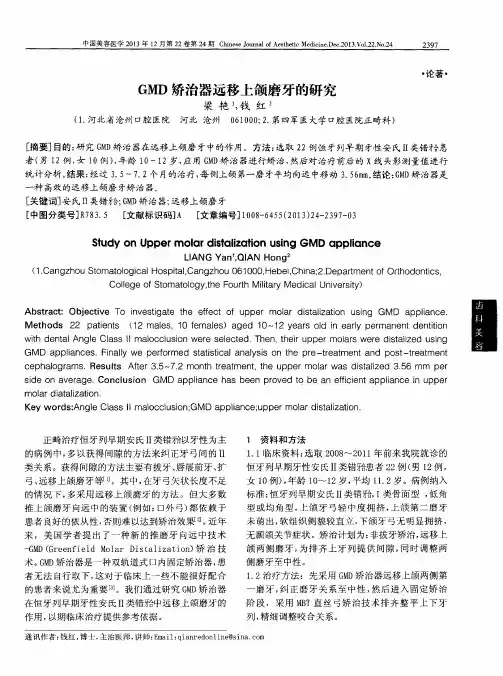
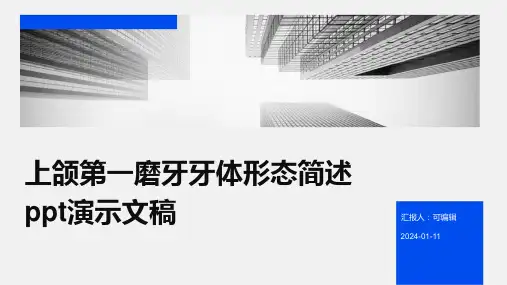
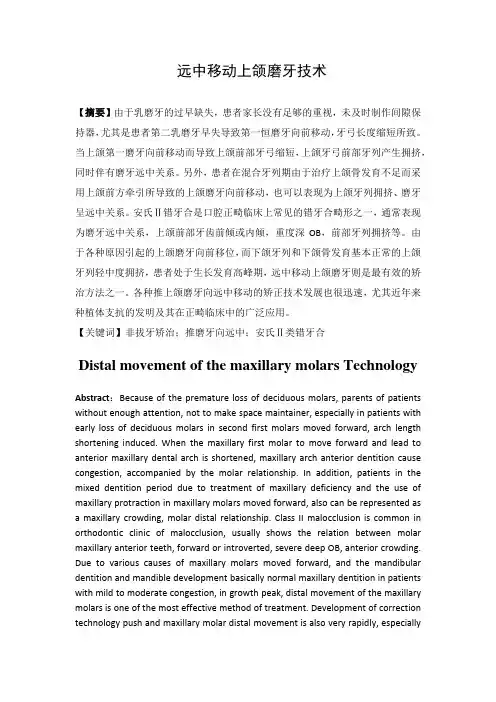
远中移动上颌磨牙技术【摘要】由于乳磨牙的过早缺失,患者家长没有足够的重视,未及时制作间隙保持器,尤其是患者第二乳磨牙早失导致第一恒磨牙向前移动,牙弓长度缩短所致。
当上颌第一磨牙向前移动而导致上颌前部牙弓缩短,上颌牙弓前部牙列产生拥挤,同时伴有磨牙远中关系。
另外,患者在混合牙列期由于治疗上颌骨发育不足而采用上颌前方牵引所导致的上颌磨牙向前移动,也可以表现为上颌牙列拥挤、磨牙呈远中关系。
安氏Ⅱ错牙合是口腔正畸临床上常见的错牙合畸形之一,通常表现为磨牙远中关系,上颌前部牙齿前倾或内倾,重度深OB,前部牙列拥挤等。
由于各种原因引起的上颌磨牙向前移位,而下颌牙列和下颌骨发育基本正常的上颌牙列轻中度拥挤,患者处于生长发育高峰期,远中移动上颌磨牙则是最有效的矫治方法之一。
各种推上颌磨牙向远中移动的矫正技术发展也很迅速,尤其近年来种植体支抗的发明及其在正畸临床中的广泛应用。
【关键词】非拔牙矫治;推磨牙向远中;安氏Ⅱ类错牙合Distal movement of the maxillary molars Technology Abstract:Because of the premature loss of deciduous molars, parents of patients without enough attention, not to make space maintainer, especially in patients with early loss of deciduous molars in second first molars moved forward, arch length shortening induced. When the maxillary first molar to move forward and lead to anterior maxillary dental arch is shortened, maxillary arch anterior dentition cause congestion, accompanied by the molar relationship. In addition, patients in the mixed dentition period due to treatment of maxillary deficiency and the use of maxillary protraction in maxillary molars moved forward, also can be represented as a maxillary crowding, molar distal relationship. Class II malocclusion is common in orthodontic clinic of malocclusion, usually shows the relation between molar maxillary anterior teeth, forward or introverted, severe deep OB, anterior crowding. Due to various causes of maxillary molars moved forward, and the mandibular dentition and mandible development basically normal maxillary dentition in patients with mild to moderate congestion, in growth peak, distal movement of the maxillary molars is one of the most effective method of treatment. Development of correction technology push and maxillary molar distal movement is also very rapidly, especiallyin recent years, implant anchorage method and its application in clinical orthodontics.Key words: non-extraction; Molar distalization; Class Ⅱ malocclusion1 引言随着人类的进化,以及饮食习惯的变化,颌骨的发育正处于相对缩小的趋势,尤其是下颌骨的发育欠佳在口腔正畸临床较为常见。

[摘要] 无托槽隐形矫治技术问世以来,因其美观舒适,受到患者的欢迎。
随着时间推移,隐形矫治材料的不断发展,软件设计的不断更新,正畸医生对该技术的应用有更深入的体会。
无托槽隐形矫治技术推磨牙向后具有整体移动,效率高,患者感受舒适,容易取得患者的理解和配合,依从性高等优点。
本文将展示典型病例,并对推磨牙向后的临床应用策略,包括适应证、附件的设计、分步的设计、牵引的使用等进行讨论,为广大正畸医生进一步学习掌握这项新技术提供指导。
[关键词] 无托槽隐形矫治技术; 磨牙远移; 垂直向控制[中图分类号] R 783.5 [文献标志码] A [doi] 10.7518/gjkq.2019069Molar distalisation by using clear aligner treatment Lai Wenli. (State Key Laboratory of Oral Diseases & National Clinical Research Center for Oral Diseases & Dept. of Orthodontics, West China Hospital of Stomatology, Sichuan University, Chengdu 610041, China)This study was supported by International Align Research Award Proposal (2017).[Abstract] Since the first appearance of clear aligners, the clear aligner technique has gained increasing interest of patients due to its aesthetic advantages. With the development in biomechanic features of the clear aligner material and innovations of digital design software, orthodontists’ understanding of clear aligner technique has been improving to a greater extent. Clear aligners have many advantages on molar distalisation, such as bodily movement, high efficiency, comfort, and high compliance. This article presents typical patients using molar distalisation approach, and discuss the treatment tactics on molar distalisation, including indication, attachment, staging and use of elastics, aiming to offering practical strategies for orthodontists who want to master the clear aligner technique in molar distal movement.[Key words] clear aligner treatment; molar distalisation; vertical control无托槽隐形矫治技术推磨牙向后的临床应用策略赖文莉口腔疾病研究国家重点实验室 国家口腔疾病临床医学研究中心四川大学华西口腔医院正畸科 成都 610041[收稿日期] 2018-12-20; [修回日期] 2019-03-27 [基金项目] 爱齐国际研究基金(2017)[作者简介] 赖文莉,教授,博士,Email :wenlilai@ [通信作者] 赖文莉,教授,博士,Email :wenlilai@开放科学(资源服务)标识码(OSID)正畸治疗的病例大多有拥挤或者前突的存在。
微螺钉种植支抗联合改良腭弓推上颌磨牙远移的临床效果探讨发表时间:2016-03-02T14:53:59.000Z 来源:《中国综合临床》2015年12月供稿作者:王玉萍[导读] 邯郸市第三医院河北邯郸056001另该矫正方法也能够在起到关键效果的同时对全口牙齿有固定矫治作用,所以临床价值较高,值得推广使用.王玉萍邯郸市第三医院河北邯郸056001【摘要】目的探讨微螺钉种植支抗联合改良腭弓推上颌磨牙远移的临床效果.方法选取22例安氏II类错合并牙拥的患者,随机分成观察组(n=11例)和对照组(n=11例),观察组患者采用微螺钉种植支抗联合改良腭弓进行矫正,对照组则采用口外弓支抗进行矫正,经X 线对头颅侧位的扫描片进行矫正效果观察,并采用统计学软件分析组间矫正效果差异.结果两组患者治疗前后在ANB、SNB、SNA、MP-SN、U1-SN、U6-PP、L6-MP、FH-MP、U1-NA、U1-NA值上均无明显差异,p>0.05,而在S1值上差异显著,且治疗后组间S1值差异明显p<0.05;组间在VAS 评分及病程时长存在显著差异,p<0.05.结论微螺钉种植支抗联合改良腭弓推上颌磨牙的疗效明显,临床价值较高,值得推广使用. 【关键词】微螺钉种植支抗;改良腭弓;推上颌磨牙远移;临床效果【中图分类号】R783.5【文献标识码】B 【文章编号】1008-6315(2015)12-0290-01随着人们对磨牙远移的认识加深,口腔内协助远移装置开始在临床广泛应用,比如弹簧、内置弯制弓、矫正器(钟摆、磁力及Jonesjig)等,这些装置能较好的加强患者的依从性,并且矫正效果可观,但同时也存在造成牙冠倾斜的弊端[1-2]. 对此,本次研究选取了2012年1月至2013年6月于我院接受上颌矫正治疗的22例安氏II类错合并牙拥的患者,随机分成2组,通过对照方法分析了外用装置口外弓与微螺钉种植支抗联合改良腭弓用于上颌磨牙远移的临床效果差异,现将详细内容做如下报道. 1资料和方法1.1一般资料选取2012年1月至2013年6月于我院接受上颌矫正治疗的22例安氏II类错合并牙拥的患者,随机分成观察组(n=11例)和对照组(n=11例).观察组应用微螺钉种植支抗联合改良腭弓矫正措施,对照组应用口外弓矫正措施.其中观察组男性6例,女性5例,年龄10~13岁,平均年龄(11.4±1.2) 岁,对照组男性5例,女性6例,年龄10~12.5岁,平均年龄(11.3±1.0)岁.组间年龄性别分布差异对磨牙远移效果无影响,p<0.05差异无意义. 纳入标准[4]:依照相关诊断标准均为上颌安氏II类错合牙并前牙拥,无牙周炎症等其它口腔系统疾病,不患影响本次研究的其它任何疾病,研究前告知家长,签署同意参与协议书. 排除标准[5]:安氏II类错合压以外的其他类型牙齿错合、牙周炎症或其它口腔系统疾病者,患影响研究结果疾病者,中途退出者,未签署同意书者以及不符合本次研究要求的其他类型患者均给予研究排除. 1.2研究方法患者入组后进行相应治疗,每治疗1个月进行一次头颅侧X线照影,并对患者进行治疗过程中VAS 疼痛评分[6](0~10分,分数越高疼痛越严重,以0分无痛,10分则表示疼痛严重患者无法忍受),记录治疗完成所需时间[7],基于统计软件比较组间及治疗前后造影参数、VAS 疼痛评分以及病程时长差异,以证实效果更好的磨牙远移方法. 1.3治疗方法对照组采用口外弓进行上颌磨牙远移治疗方法[8]:选用传统的全口方丝弓矫正器.根据患者的具体情况选取头帽与唇弓尺寸合适的口外弓矫正器,调整内弓后,使其与患者牙齿吻合就位,使用橡皮圈与唇弓及头帽的纽扣处连接进行联合牵引,两侧的力度均大约为0.25kg,每天戴13h左右,每连续治疗1个月后进行1次复诊检查. 观察组采用螺钉种植支抗联合改良腭弓措施:首先观察曲面断层片上颌第二前磨牙和第一磨牙牙根尖骨质情况及上颌窦底位置,选择中邦公司1.5X12mm 或2.0X12mm微螺钉种植支抗,在上颌两侧第二前磨牙和第一磨牙间腭侧牙龈缘下8mm处做切口,打入支抗钉,2周后加力.然后用1.0mm 不锈钢丝弯制上颌改良腭弓,使牵引钩位于上颌尖牙和第一前磨牙间的腭侧,与种植钉成一直线,焊接要牢固,防止假焊.远移磨牙力量为150g左右,远移到位后注意保持至少3个月,注意上颌第二磨牙和第三磨牙的情况,防止复发.每隔1个月后进行复诊检查. 1.4影像评定方法治疗前后均经头颅侧X线照影,参考文献[10]方法经过头颅侧影片对眼耳平面(FH)、颅底平面(SN)、下颌平面(MP)及腭平面(PP)进行标示,然后通过测量垂线的距离以ANB、SNB、SNA、MP-SN、U1-SN、U6-PP 、L6-MP、FH-MP、U1-NA、U1-NA 几个参数来评定上颌磨牙的相对平面的距离角度改变情况,而以S1评定上颌磨牙远移情况,并做组间比较. 1.5统计学方法研究中一般资料、VAS 评分、病程时长以及影像参数数据均采用SPSS21.0软件进行统计,其中性别比例数据应用百分号表示,进行卡方检验,而年龄、VAS 评分、病程时长以及影像参数则应用“平均数±标准差”表示,进行t检验,以α<0.05表示差异有可比较性. 2结果2.1两组患者治疗前后影像参数比较两组患者治疗后6个月较治疗前的ANB、SNB、SNA、MP-SN、U1-SN、U 6-PP 、L6-MP、FH-MP、U1-NA、U1-NA值均无明显差异p>0.05,但S1差异明显,经t检验p<0.05,表明微螺钉种植支抗联合改良腭弓与口外弓支抗均能对上颌磨牙远移起到较好的推进作用, 且对上颌磨牙相对平面的距离以及突度影响不明显;治疗后观察组患者的S1值明显低于对照组,经t检验,p<0.05,表明微螺钉种植支抗联合改良腭弓用于上颌磨牙远移的作用强于传统的口外弓支抗,见表1.表1两组患者治疗前后影像参数比较3讨论在本次研究中主要技术路线及创新点为:①微螺钉种植支抗的位置及加力时间:在上颌两侧第二前磨牙和第一磨牙间腭侧牙龈缘下8mm 处,打入1.5×12mm或2.0×12mm支抗钉,2周后加力.②上颌改良腭弓的制作:用1.0mm 不锈钢丝弯制上颌改良腭弓,使牵引钩位于上颌尖牙和第一前磨牙间的腭侧,与种植钉成一直线,焊接要牢固,防止假焊.③远移力量问题:远移磨牙力量为150g 左右,远移到位后注意保持至少3个月,注意上颌第二磨牙和第三磨牙的情况, 防止复发.该种方法可采用在上颌两侧第二前磨牙和第一磨牙间腭侧植入种植支抗钉,结合上颌改良腭弓挂橡皮链推上颌第一磨牙远移开拓间隙,改善远中磨牙关系及排齐上颌牙齿,保持正常面型,使患者免除拔牙的痛苦,克服了患者戴用口外弓推磨牙远移配合的困难,提供强支抗,治疗的同时可以行全口固定矫治,缩短矫治疗程.在本次的研究结果中很好的证实了这一结论.对于微螺钉种植支抗联合改良腭弓推上颌磨牙远移能够减轻患者的痛苦并缩短病程的验证:本次研究中观察组患者的VAS 疼痛评分为(3.17±0.48)分,而对照组患者为(4.92±0.73)分,观察组明显低于对照组p<0.05, 依照VAS 疼痛评定原则,观察组患者的疼痛度明显轻于对照组,即微螺钉种植支抗联合改良腭弓推上颌磨牙远移比传统外口弓对患者造成的痛苦小.另观察组患者的病程时长为(5.32±1.04)月,而对照组则为(7.64±1.35)月,前者显著比后者低,由此可见: 微螺钉种植支抗联合改良腭弓推上颌磨牙远移能明显缩短病程. 综合研究:微螺钉种植支抗联合改良腭弓推上颌磨牙的疗效明显,能够较好的保持正常面型,免除拔牙的痛苦,克服患者戴用口外弓推磨牙远移配合的困难,较大程度缩短了矫治疗程;另该矫正方法也能够在起到关键效果的同时对全口牙齿有固定矫治作用,所以临床价值较高,值得推广使用.参考文献[1] 魏惺,赵立星,许桢睿,等.关于中国人正畸支抗用微种植钉牙槽骨植入安全区的研究[J].国际口腔医学杂志.2010.(02):128-132. [2] 王彬,谈龙,施洁裙,等.微种植支抗远移下牙列的临床研究[J].实用口腔医学杂志.2013.29(2):236-240. [3] 许志强,史建陆,任继业,等.钦合金/不锈钢微植体支抗稳定性的组织学研究[J].实用口腔医学杂志.2012.28(5):574-577. [4] 郭萍.利用微种植钉支抗滑动法近中移动下颌第一磨牙关闭第一磨牙缺失间除的疗效分析回.杭州:浙江人学医学院.2011. [5] 郭剑虹,张风华,韩壮,等.微种植钉支抗技术在压低上颌伸长磨牙中的应用研究[J].河北I药,2013.35(4):508509. [6] 王旭,张栋梁,王锐.二段弓技术与微种植支抗技术压低和内收上切牙效果的对比研究[J].口腔医学研究,2011.27(4):323-327.。
第39卷第1期2021年1月佛山科学技术学院学报(自然科学版)Journal of Foshan University (Natural Sciences Edition )Vol. 39 No. 1Jan. 2021文章编号:1008-0171(2021 )01-0039-06安氏II 类推上颌磨牙远移矫治方法新进展陆茵,孔卫东*收稿日期:2019-12-21基金项目:广东省科技计划资助项目(2016A020220015);广东省科技计划资助项目(2015A020214015)作者简介:陆 茵(1995-),女,广东佛山人,暨南大学硕士研究生。
*通信作者:孔卫东(1965-),男,广西平南人,暨南大学主任医师,博士生导师。
(暨南大学口腔医学院,广东广州510000)摘要:目的推磨牙远移是临床解决拥挤问题使用较多的方法,在安氏II 类及安氏III 类轻中度拥挤病例上较为 常用。
方法针对安氏II 类病例上颌推磨牙远移的时机、上颌磨牙的远移距离、推上颌磨牙远移较为常用的几种 矫治方法及其优缺点进展进行综述。
结果研究结果表明现有的几种推磨牙远移矫治技术如口外弓、摆式矫治 器、Frog 矫治器、GMD 磨牙远移器、微种植支抗、隐形矫治器均在安氏II 类轻中度拥挤病例矫治方面拥有良好 效果,其中微种植支抗联合摆式矫治器的磨牙远移距离较为显著。
结论隐形矫治器磨牙远移拥有特有的优势和 很大的发展潜力,但其生物力学机制仍需进一步研究。
关键词:上颌磨牙远移;安氏II 类错合;矫治方法中图分类号:R782 文献标志码:A随着矫治技术的发展,越来越多病例可以通过非拔牙矫治解决。
对于轻中度拥挤病例,推磨牙向远 中创造间隙用于排齐牙齿,从而避免拔牙,符合当前流行的健康矫治理念。
目前,对于安氏II 类轻中度 拥挤病例、安氏III 类轻度拥挤病例均有文献报道[1-2],可以通过推磨牙向远中的方式矫治。
推磨牙向远 中移动作为错合畸形研究的热点内容,学者们针对错合畸形的特点采取了多种方法,如头帽J 钩配合 口内固定矫治器、口外弓联合滑动杆、钟摆式矫治器、Frog 矫治器、双轨道滑动装置、微种植支抗配合口 内固定矫治器以及无托槽隐形矫治等。
远中移动棒结合种植体支抗移动上颌牙列的临床应用目的:探讨正畸矫治中远中移动磨牙的有效方法。
方法:对21例安氏Ⅱ错患者采用远中移动棒与微种植体支抗有机结合,远中移动上颌磨牙的方法,观察其矫治后磨牙关系的改变情况。
结果:患者的上颌磨牙均实现有效远移,解除上颌牙列的拥挤,达到Ⅰ类关系。
结论:应用远中移动棒结合微种植体支抗可以有效解除牙列的拥挤,为牙列拥挤的非拔牙矫治提供了一种新方法。
[Abstract] Objective: To discuss the effective treatment method during upper teeth backwards movement in clinical practice. Methods: Make upper teeth backwards with CD appliance combined MIA as anchorage for 21 patients of Angel Ⅱocclusion, to observe the change of molar teeth. Results: Upper molars have achieved backwards movement effectively,relieved crowded of upper teeth, reached classⅠor over-classⅠrelations. Conclusion: Practice with CD appliance and MIA together in clinical can achieve teeth backwards effectively, is a new technic curing teeth crowded beyond nonextraction treatment.[Key words] Carriere Distalizer; Microscopic implant anchorage; Molar backwards; Teeth crowded上颌前牙拥挤、磨牙Ⅱ类关系是临床上常见的错类型,对下颌骨发育正常的Ⅰ类骨面型或轻度的Ⅱ类骨面型的患者常采用非拔牙矫治,可通过远移上颌磨牙的方法来纠正磨牙关系,解除上牙弓拥挤。